Samsung SGH-D600 Review
Samsung SGH-D600
Unlike the undoubtedly cool looking Nokia 8800, the Samsung D600 combines both style and substance.
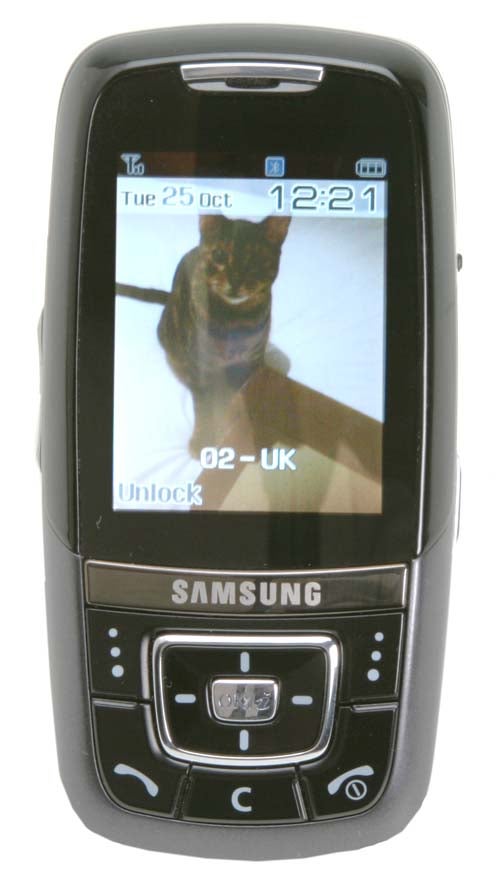
Verdict
I’ve been a long term Sony/Ericsson mobile phone user, but although I thought that the T610 was a cut above the competition when it launched in 2003, I found the K700i a distinct disappointment. So, when upgrade time rolled around again, I decided against the Sony/Ericsson K750i, despite it being a vast improvement on the K700i. Instead I chose to hang on until the launch of the Samsung D600, which looked, on paper at least, to be a great little phone.
I’d never really been a fan of Samsung phones until the launch of the D500. Not only was the D500 a great looking phone with a cool sliding mechanism, but it was also the first Samsung phone with integrated Bluetooth – something that no one should be without. With the D500 Samsung showed that it really could build a mobile phone to challenge Nokia and Sony/Ericsson.

The D600 builds on the success of the D500, but brings with it some outstanding new features. Without a doubt the most impressive feature on the D600 is the screen. The 2in screen boasts a stunning resolution of 240 x 320 – now this might not seem that high compared to your average monitor, but squeezing that many pixels into a screen only two inches in size isn’t easy. The result is a truly stunning image, where digital photos look fantastic, and make other phone screens look dated and blocky. When you shoot a photo with the D600 and set it as your wallpaper it really does look great and I’ve yet to find anyone that hasn’t been impressed with its quality.
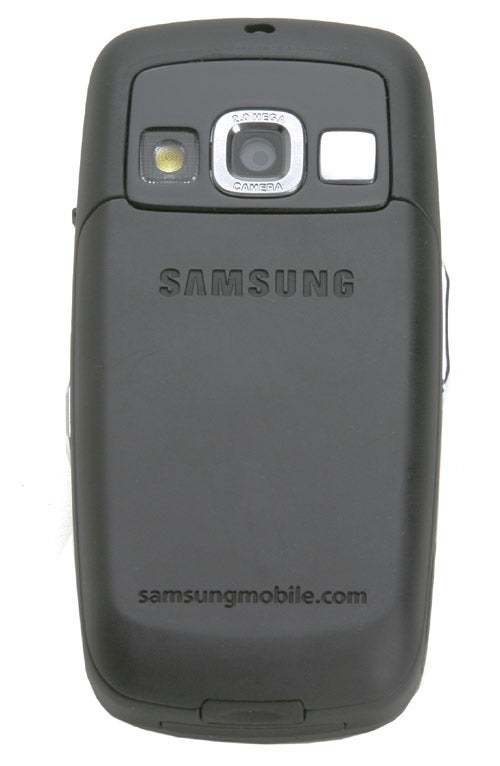
Since I’ve mentioned taking a picture already, I’ll cover the camera next. Samsung has included a two megapixel camera in the D600 giving you a maximum resolution of 1,600 x 1,200. The results from the camera are superb, although there is a somewhat annoying shutter lag – don’t expect to catch anything impromptu if it’s fast moving. The lens and flash/light are mounted on the rear of the phone body, unlike the D500 where the lens and light are only visible when the screen portion of the phone has been slid upwards. I think I prefer the way the older phone does it, since your lens is always protected when not in use.
I really love the sliding mechanism on the D600 – I’m not a big fan of flip phones, and it can be a pain having to lock the keys on a candy bar phone, so a sliding phone like the D600 gives me the best of both worlds. Strangely Samsung has chosen to remove the rubber bar that ran across the width of the D500 – this made it really easy to slide the phone open. That’s not to say that the D600 is difficult to slide open, but you have to push the side of the phone or the screen – pushing from the bottom does work, but can result in you dropping it by mistake – trust me on this, I know!
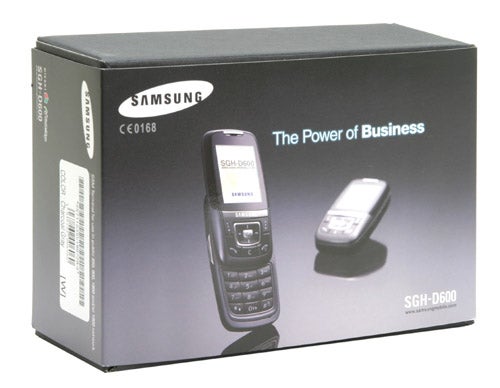
The front of the phone is dominated by the screen – did I mention that it’s gorgeous? Below the screen you’ll find two soft buttons, Call and End buttons, a Clear button, a four-way navigator pad and a central OK button. That’s quite a lot of stuff squeezed into a small space, but on the whole it’s all pretty easily accessible as long as you have a dexterous thumb. The buttons are automatically locked when the phone is slid closed, but you can unlock them without opening it up again. That said, sliding the D600 open is a lot quicker and easier than pressing the two button combination to unlock it. Sliding the phone open reveals the full numeric pad.
The menu navigation is similar to a Sony/Ericsson environment and pretty much everything is where you’d expect it to be. You can also assign shortcuts to the four-way navigation pad for easy access. One thing that I did find annoying was that the centre OK button doesn’t bring you to the main menu, instead it launches the Internet browser. To be fair though, this is because I’m used to Sony/Ericsson phones and it just took me a little time to get used to pressing the dedicated Menu button instead.
Like the D500 before it, the D600 has integrated Bluetooth, but unlike the D500, the D600 doesn’t have infrared. Now I guess there’s an argument for not needing infrared when you have Bluetooth, but sometimes it’s just easier and quicker to send something over infrared since you don’t have to worry about pairing.
Unfortunately Bluetooth is where one of the D600’s major weaknesses rears its head. I use a Bluetooth headset whenever I’m driving, and I have always assigned voice-dial commands to key contacts so that I can call them without having to touch my phone. However, the D600 doesn’t support voice dialling, something that I found hard to believe when I first started using the phone. But after hours of trawling through menus and pawing over the manual, it’s clear that voice dialling is something that Samsung hasn’t deemed important. Unfortunately for me it is very important and this is my biggest disappointment with the handset as a whole.
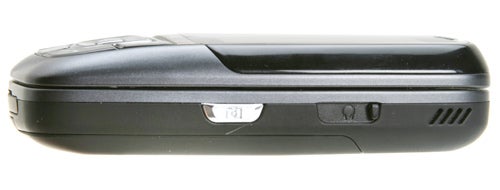
If you’re a regular world traveller you’ll be happy to hear that the D600 is a quad-band phone, supporting GSM 850, 900, 1800 and 1900 – so you should be able to get a service pretty much all over the world.
The D600 doesn’t have quite as much built-in memory as the D500, with 76MB of user accessible storage on offer. However, you could argue that the D600 has limitless memory capacity since it has a slot for TransFlash cards – although the correct name is now microSD. What’s great about the memory card slot on the D600 is that it’s easily accessible. On the left side of the phone, where the infrared port sits on the D500, is a little flap that hides the microSD card slot – although it’s labelled T-Flash. Many phones hide the memory card behind the battery, which means that you have to switch the phone off in order to change cards, but with the D600 swapping cards is a simple and quick procedure.
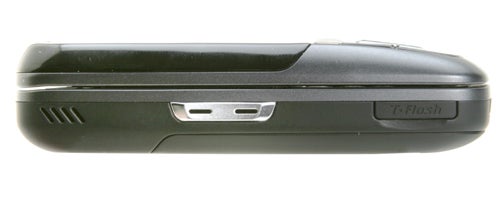
Unfortunately Samsung doesn’t supply a memory card in the box, but to be fair, with 76MB of storage built into the phone I didn’t really expect to find one. However a quick call to the guys at SanDisk resulted in a 512MB microSD card landing on my desk a couple of days later. Despite having seen microSD cards before it never ceases to amaze me just how tiny they are – quite how 512MB has been squeezed into a card this small is beyond me. Once I’d slid the microSD card into the slot, the D600 instantly recognised it, and added a memory card icon to the top of the phone’s main screen. The phone automatically creates the correct file structure on the card and creates folders for Images, Music and Video. You can access the contents of the card through the File Manager option under the main menu.
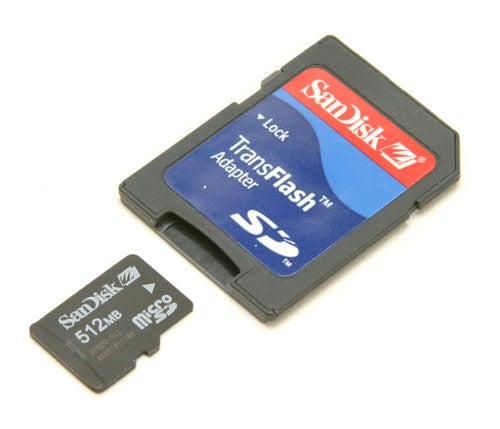
With a decent size memory card in your phone you can, if you so wish, use it to watch video. Now I’ve never been an advocate of watching video on a phone due to the small screen, but I have to say that the quality of the screen on the D600 has gone some way to convincing me. Fire up a 3GP MPEG4 video in the integrated media player and it looks pretty good, but then press number 1 on the keypad and the video will zoom to full screen and switch to landscape mode. When viewed like this, video really does look great and even the integrated speakers are decent enough to do the movie you’re watching justice.
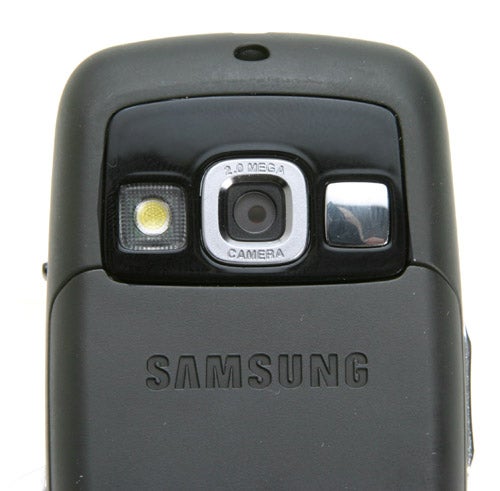
Strangely you can’t access the memory card when using the Samsung PC software – you can see the whole file structure of the phone’s internal memory, but you can’t see the memory card if you have one installed. However, you can enable the Mass Storage option under the USB settings, which will make the memory card show up as a removable drive under Windows. Another solution is to use a separate memory card reader and a microSD to SD card converter in order to get content onto the card.
Talking of PC connection, Samsung kindly bundles a USB cable in the box. Not only does this cable allow you to connect the D600 to your PC for synchronisation and data transfer, but it will also charge the phone up while it’s connected. Unfortunately the D600 only uses a USB 1.1 interface, so if you’re copying a large amount of data to it you’ll be in for a long wait – in fact the D600 is slow even for a USB 1.1 device. Ultimately you’re better off just using a memory card reader instead.
Also in the box is a CD with Samsung PC Studio 3.0. This is pretty decent software that lets you manage the files on your D600, synchronise your contacts, schedule, notes and memos with Outlook, and even edit your movies, sounds and pictures. I always like to see Outlook synchronisation, since it lets you keep your diary in your pocket with you all the time.
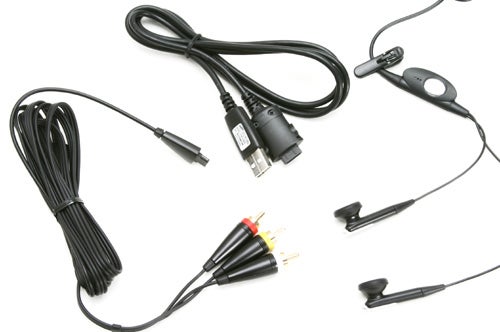
There’s a hands free headset in the box too, with stereo headphones for listening to music. Unfortunately I found the ear buds too large to sit comfortably in my ears, although Lars found them perfect. The big criticism I have here is that you can’t plug in your own headphones. This would be easy to do as NEC showed with the N411i – on that phone the microphone part of the headset had a standard 3.5mm mini-jack socket, so you could use any headphones, while maintaining the headset functionality. Of course Samsung isn’t the only manufacturer to fall foul of this issue, but with a cutting edge phone like the D600, I had hoped that I wouldn’t encounter it.
Besides the charger, there is one other cable in the box – a TV out cable. That’s right, amazing as it sounds, you can hook the D600 up to an external screen and show your content to a wider audience. The video connection is only composite, so don’t expect a perfect picture, especially if you’re playing back video – the 3GP files will just look too blocky and pixelated on a large screen. However, the TV-Out functionality could be useful if you need to give a presentation and don’t want to carry a notebook with you. You could view your PowerPoint or Acrobat presentation directly from the phone and output it to an external screen or projector.
File viewing is just another cool trick that the D600 has up its sleeve. You can simply copy Word, Excel, PowerPoint or Acrobat files over to the phone and view them. Of course the small screen does limit the usefulness of the files, but the high resolution of the screen does make it possible to read documents at a push – quite handy if you have an important itinerary in a Word document or PDF.
Unlike the NEC i-mode handset I looked at a couple of weeks ago, you don’t get any push email with the D600. However, you can assign multiple POP3 email accounts to the phone, and once set up, sending and receiving email is a breeze – you’ll probably find that it’s cheaper to send an email with a picture attachment than sending a multimedia message too!
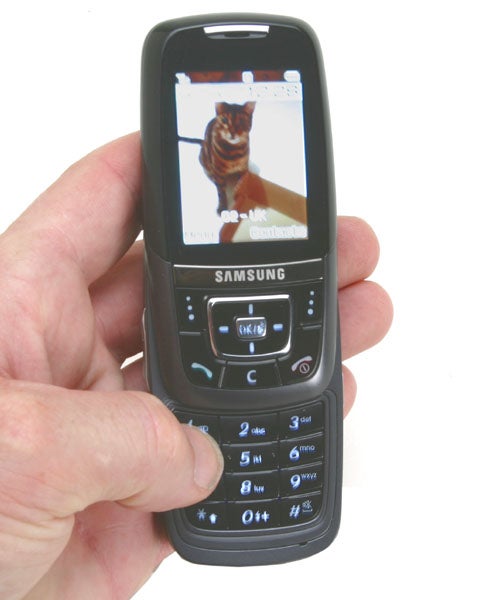
Depending on your contract you can pick the D600 up for free and I have to say it’s a hell of a lot of phone to be getting for nothing. It’s not 100 per cent perfect, but Samsung has definitely proved that it can make a well designed, well featured and incredibly stylish phone. The D500 was good, but the D600 is so much better.
”’Verdict”’
The D600 is a great looking phone with a screen that puts other handsets to shame. The feature set is very impressive, which makes the lack of voice dialling all the more bizarre. The camera takes great pictures and video and the memory card slot means that you can store as much data as you like. It’s also good to see a USB cable in the box for PC synchronisation, while the TV-out cable is an added bonus. Obviously hardcore Nokia fans or Sony/Ericsson addicts will turn their nose up at a Samsung phone, but they will be missing out on what is, essentially one of the best handsets on the market right now.
How we test phones
We test every mobile phone we review thoroughly. We use industry standard tests to compare features properly and we use the phone as our main device over the review period. We’ll always tell you what we find and we never, ever, accept money to review a product.
Trusted Score
Score in detail
-
Usability 9
-
Value 9
-
Features 9

